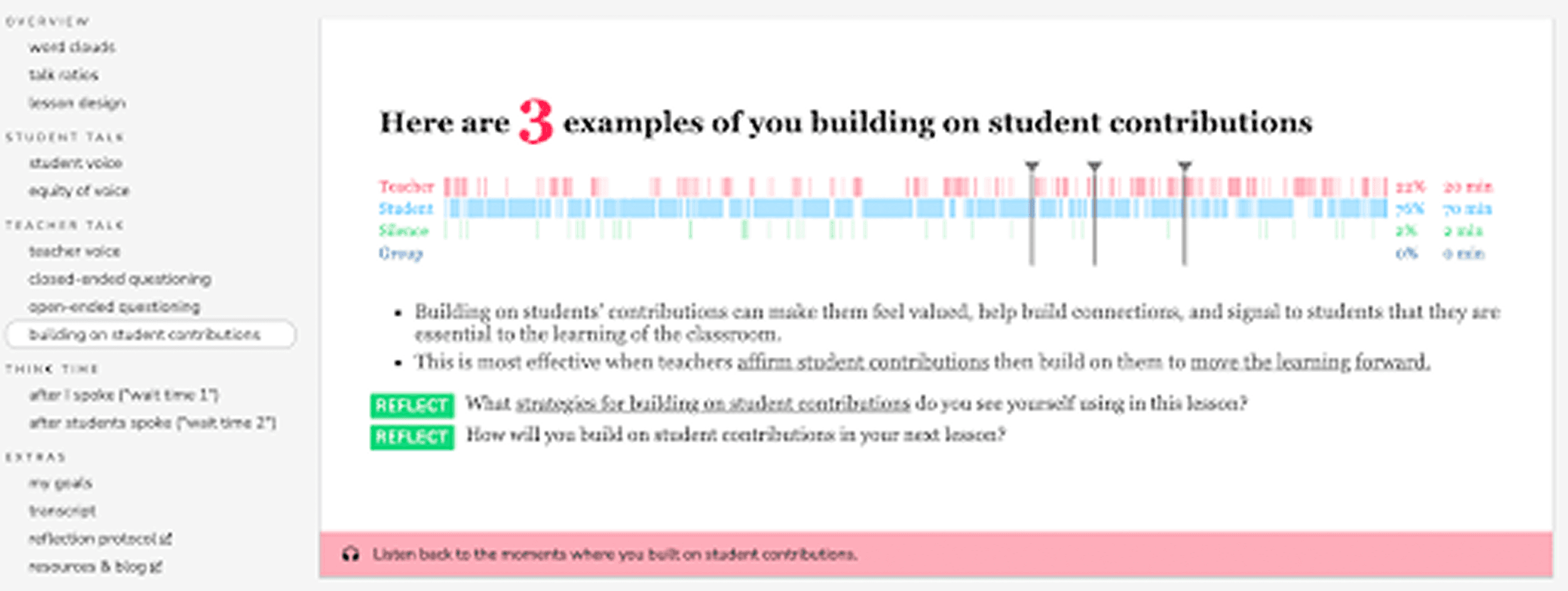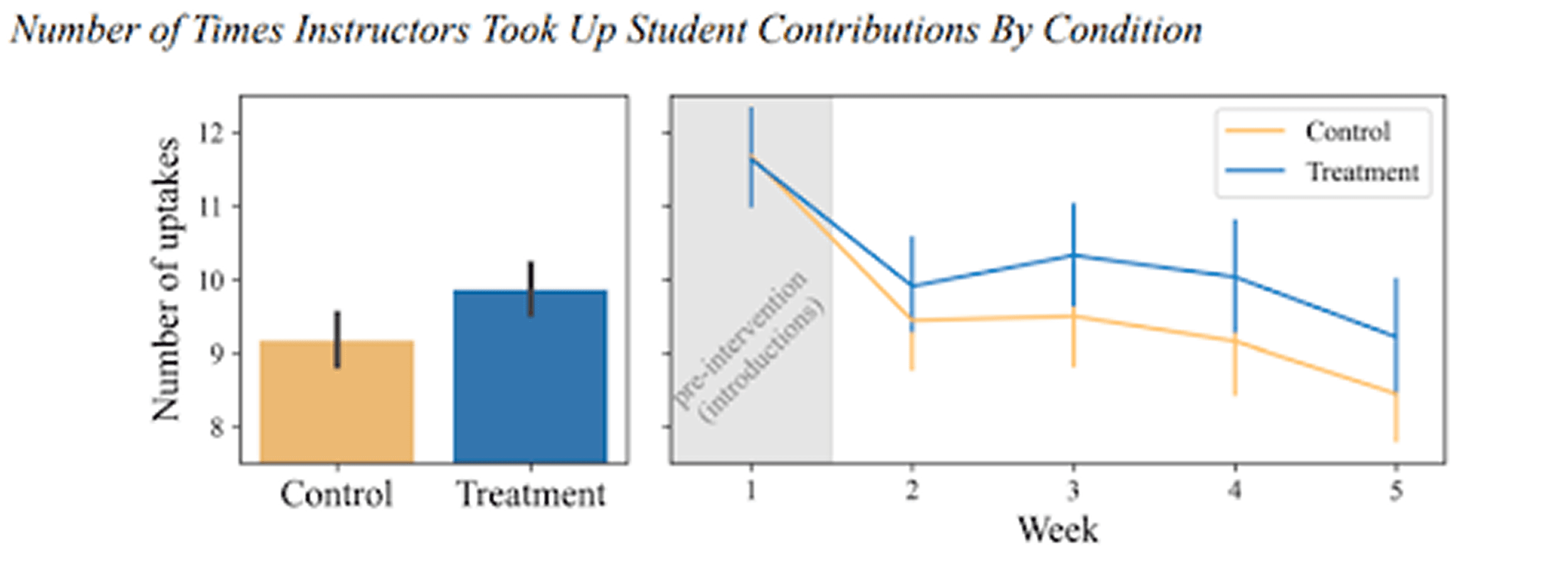
New Independent Research: How automated feedback empowers teachers to improve learning
When students speak more in the classroom, they learn more. That’s why a teacher’s practice of building on student contributions -- what researchers call “teacher uptake” -- is critical.
When done well, it fosters both student agency and engaged learning.
In fact, the more teachers engage in this practice, generally, correlates with higher teaching quality. As the researchers of this recent study state:
“When teachers take up student contributions by, for example, revoicing them, elaborating on them, or asking a follow-up question, they amplify student voices and give students agency in the learning process.”
But, improving uptake is an incredibly complex thing to do. Even for experienced teachers.
The results of the randomized controlled trial released by researchers from Stanford University, Harvard University, and the University of Maryland, prove the power of automated feedback to help teachers increase uptake of students’ ideas and improve students’ learning experience.
What’s more, the technology studied here is the very same tech that powers key pieces of the TeachFX app.
The building on student contributions feature in TeachFX helps teachers measure how they’re engaging in this practice -- also called uptakes in this research -- by providing specific data and insights on how that’s happening in the classroom. (Drop us a note if you’d like to see it in action.)

Teach FX champions learning through talking. And this research affirms that automated, personalized feedback tools like TeachFX can deliver the same valuable instructional insights more efficiently than an instructional coach.
Read on to learn more about how this research drives home how vital it is that such feedback be provided consistently, at scale, in a way teachers can easily make use of.
Teachers need regular, objective feedback on their instruction in order to develop and grow professionally.
Feedback is vital for teachers. It’s key to improving both teachers’ instruction and students’ learning.
Yet, as the study states, “Providing consistent, individualized feedback to teachers is essential for improving instruction but can be prohibitively resource intensive in most educational contexts.”
Teachers in the k12 environment, at best, often receive just a few hours of professional development per year. And many don’t receive even a single opportunity for direct classroom observation and feedback in any given year.
Principals only have so many hours to give to so many competing priorities, including teacher observation and feedback. And, the number of teachers who’d benefit from feedback on their instruction far eclipses what the typical instructional coaching staff is able to support.
Automated feedback augments the opportunities teachers have to receive feedback, and puts objective data in teachers’ hands, on their schedule..
Professional development options alone don’t solve the problem either.
As the researchers point out, too many PD options have actually been shown to have little or no effect on teaching outcomes:
“In a recent STEM meta-analysis, less than half of math and science PD program impact estimates showed positive effects on teacher knowledge and practice; only one third showed positive impacts on student outcomes (Lynch et al., 2019).”
“A related review of 76 IES-funded studies found that 36% of the interventions had no positive impact on teacher practice (Hill & Erickson, 2019).”
This makes feedback even more vital for teachers, despite the obstacles to providing it.
Automated feedback makes vital information available to teachers, consistently, and at scale.
Feedback from principals and instructional coaches have proven to be vital to teachers. But, expecting them to support all of our instructional staff with continuous, objective feedback is simply not practical.
How can we scale their impact to ensure our teachers are getting the continuous feedback they need to continuously improve their instructional practices?
The research shows that technology-enabled instructional feedback offers a practical, impactful, and cost-effective solution.
By automating the delivery of objective feedback to teachers, they get the feedback they need to refine their teaching practices even when principals or instructional coaches can’t be in the room to provide individual support.
What’s more, this research proves the extent to which this kind of feedback, at scale, directly impacts teaching and learning.
The research finds that when instructors receive automated feedback on their teaching, they meaningfully increase practice of building on student contributions -- what researchers call “teacher uptake of students’ ideas -- and they create a more positive student experience.
Specifically, having access to a natural language processing tool, like the one that TeachFX runs on, gives teachers feedback on their uptake of student contributions and improves uptake of student contributions by 13% and improves students’ satisfaction.
This is illustrated clearly in three key findings:
Automated feedback empowers teachers to view their practice in a new light.
57% of instructors reported that the feedback helped them become a better teacher. And 76% indicated that the feedback made them realize things about their teaching that they otherwise would not have.
Teachers find automated feedback to be accessible and actionable.
64% of instructors answered that the feedback “wasn’t difficult to understand.”
Automated feedback for teachers helps improve students’ learning experience.
Students enrolled in sections with instructors who received automated feedback were more likely to find their section helpful and recommend the class.
What’s more, students whose teachers looked at their feedback more frequently, were even more satisfied and engaged with the course.
So, not only does automated feedback help improve the learning experience...the more teachers make use of that feedback, the greater the net effect on the learning experience.
Aided by automated feedback, these teachers integrated one more student contribution per class period and asked roughly six more questions per class period.

Automated feedback provides teachers with powerful, non-judgmental feedback on their teaching practice.
Teachers with access to automated feedback preserve agency and authority over their practice, while getting the data they need to move past assumptions and guide their own growth.
This leads to better, more collaborative and productive conversations between teachers and their principals or coaches. Because rather than discussing feedback that can feel subjective, the teacher and principal or coach are discussing the same, objective data, together.
Key findings for making feedback actionable for teachers
The research highlights many of the same practices and premises that TeachFX teachers have already experienced.
Specifically, the research reinforces that impactful teacher feedback is:
Provided as informative, non-judgmental resource, and not evaluative.
Truly objective information placed in the hands of teachers is empowering. It “respects (teachers’) agency and authority over their practice.”
This information is meant to inform teachers on their own practice. It’s not to be used by others to evaluate them.
Similarly, TeachFX data is available only to the teachers themselves. They’re free to share this information with their principals and colleagues. But not required.
Framed in a way that guides teachers to think through the implications themselves.
Alongside the feedback itself, researchers provided open-ended reflection questions to help each teacher interpret their feedback themselves.
This, again, provides teachers with the feedback they need, while actually boosting their agency and authority over their own practice.
It’s important to note that this is also effective because the feedback is not being used in an evaluative manner, but to truly help teachers own their own development.
TeachFX expert educators collaborate with our partners to customize inquiry-based professional learning experiences that help build a culture of reflective instructional practice.
Communicated through simple, actionable, and consistent means.
Teachers are incredibly busy, and increasingly stretched thin. For feedback to be effective and actionable, it has to be simple to absorb. And it cannot be overwhelming.
What’s more, when feedback is provided consistently, teachers can see their progress over time. Rather than static point-in-time feedback that might happen with a principal or instructional coach, automated feedback is consistent over the long term.
Like the automated feedback in this study, TeachFX feedback is provided nearly in real time. Meaning that what actually was happening in the classroom is still fresh in a teacher’s mind.
Teachers who use TeachFX find that it allows them to reflect meaningfully and regularly on their instruction at their own convenience.
Empowering teachers with job-embedded feedback is the way forward.
TeachFX is founded on the premise that when teachers are empowered with job-embedded feedback, they own their own development.
It’s nearly impossible to provide teachers with consistent, actionable, personalized feedback, without using automated technology. And professional development is often ineffective when not paired with that feedback.
These rigorous, independent research findings validate TeachFX’s mechanism as solving this persistent challenge. At scale. Both efficiently and effectively.
Automated feedback can play a vital role in improving instruction and creating a better student experience.
It empowers teachers to have these “aha” moments, and allows teams to use precious instructional coaching and PLC time for building on that learning.
And that’s empowering educators to build a clear vision for how this will help to create effective, evidence-driven communities of practice.
Research like this is opening the door to continued, expanded conversations about the power of automated feedback to empower teachers to increase student engagement and improve the learning experience.
Ready to learn how TeachFX can help you create a culture of reflection and feedback?
Schedule a time to talk with us. Or, try TeachFX for free right now.
Guest user


